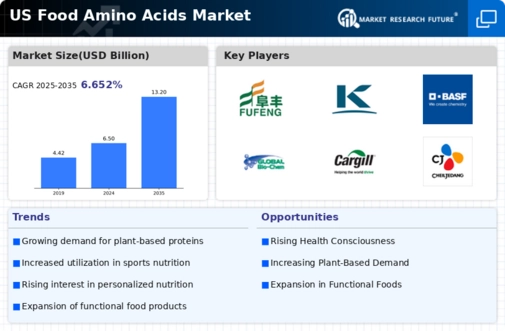Growth in Pet Nutrition
The food amino-acids market is also experiencing growth due to the increasing focus on pet nutrition in the US. Pet owners are becoming more aware of the nutritional needs of their pets, leading to a rise in demand for high-quality pet food that includes essential amino acids. These amino acids are crucial for maintaining the health and vitality of pets, and as a result, pet food manufacturers are incorporating them into their products. The pet food market is expected to reach $100 billion by 2027, suggesting a substantial opportunity for the food amino-acids market to expand its offerings in this segment, catering to the nutritional needs of pets.
Expansion of Sports Nutrition
The food amino-acids market is significantly influenced by the expansion of the sports nutrition sector in the US. With an increasing number of individuals engaging in fitness activities and sports, there is a heightened demand for nutritional products that support athletic performance. Amino acids are essential for muscle repair and growth, making them a critical component of sports nutrition. The market for sports nutrition products, which includes amino acid supplements, is expected to grow at a CAGR of around 8% over the next few years. This growth is likely to drive the food amino-acids market as manufacturers innovate and develop specialized formulations tailored for athletes and fitness enthusiasts.
Increasing Health Consciousness
The food amino-acids market is experiencing a notable surge due to the increasing health consciousness among consumers in the US. As individuals become more aware of the importance of nutrition, there is a growing demand for products that enhance health and wellness. This trend is reflected in the rising consumption of amino acids, which are recognized for their role in muscle recovery, weight management, and overall health. According to recent data, the market for dietary supplements, including amino acids, is projected to reach approximately $50 billion by 2026, indicating a robust growth trajectory. The food amino-acids market is thus positioned to benefit from this heightened focus on health, as consumers actively seek out amino acid-enriched products to support their dietary needs.
Rising Popularity of Functional Beverages
The food amino-acids market is benefiting from the rising popularity of functional beverages in the US. Consumers are increasingly seeking drinks that offer health benefits beyond basic nutrition, and amino acids are often incorporated into these beverages to enhance their appeal. Functional drinks, such as protein shakes and energy drinks, frequently contain amino acids to support recovery and energy levels. The functional beverage market is projected to grow by approximately 10% annually, which could positively impact the food amino-acids market as beverage manufacturers look to include amino acids in their formulations to meet consumer demand for health-oriented products.
Technological Innovations in Food Processing
The food amino-acids market is poised for growth due to technological innovations in food processing. Advances in extraction and synthesis methods are enabling manufacturers to produce amino acids more efficiently and at lower costs. This not only enhances the availability of amino acids in various food products but also improves their quality and efficacy. As food processing technology continues to evolve, the food amino-acids market is likely to see an increase in the incorporation of amino acids into a wider range of food products, appealing to health-conscious consumers and those seeking functional benefits from their diets.


















Leave a Comment